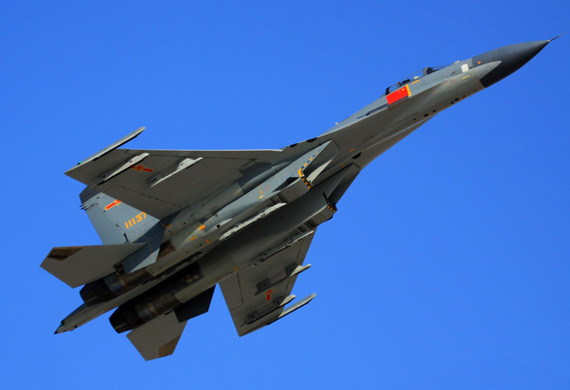| The China Syndrome
中国用复制武器削减俄罗斯市场 Date:2013-10-26 Source:strategypage By:globalmil Viewed: |

中国空军装备的歼11型战机,其原型为俄制苏-27SK战斗机
May 9, 2010: Using stolen Russian technology, China is on its way to driving Russia out of the low-end weapons business. In turn, Russian attempts to maintain their status as a major developer of military technology are fumbling, largely because of the sales stolen by China. Increasingly, China is undercutting Russian sales efforts with similar weapons containing lots of stolen Russian technology. The Chinese won't invest as much in developing new technology, and the Russians can no longer afford to. So the second tier weapons markets slide further into mediocrity.
2010年5月9日:中国利用从俄罗斯窃取的技术,正在把俄罗斯赶出低端武器市场。反过来,俄罗斯也难以维持其军事技术重要开发国的地位,这在很大程度上是因为中国抢走了俄罗斯的客源。日益,中国利用包含诸多窃取自俄罗斯的技术的类似武器侵蚀俄罗斯外销努力。中国人不会在研发新技术上投入同样多的资金,而俄罗斯人再也无力负担。因此,第二等武器市场进一步陷入了二流水平。
Through the most (1960s-80s) of the Cold War, Russia(Soviet Union) had a well financed arms industry. Many innovative weapons were developed, but all this effort was hobbled by the fact that the Russian economy as a whole was very inefficient, and Russian industry could not build high tech as well, or reliably, as Western firms could. Thus Russian high-tech gear always came in second to Western counterparts.
经过最大的冷战(1960-80年),俄国(前苏联)有了一个完全财政的武器工业。发展许多创新的武器,但所有这一切努力因为俄罗斯经济整体上非常低效的事实步履蹒跚,并且俄国工业也不能或可靠地开发高科技,同时西方公司可以。因此俄国高科技装备总是处在西方类似版本的二等地位。
When the Cold War ended, so did the lavish spending for the Russian defense industries. Many, actually over half, of these weapons manufacturers went bankrupt, or converted to non-military production. Those that survived, did so by exporting weapons. Throughout the 1990s, the Russian armed forces could not afford to buy much new stuff. China came to the rescue in the 1990s, and over the next decade, bought nearly $20 billion in Russian arms. But China also began to blatantly copy lots of the Russian tech, and build their own. Thus, not surprisingly, for the last five years, Chinese orders have shrunk, while production of copies of Russian tech have increased. In some cases, Russia has simply refused to sell China high tech stuff, to avoid having it copied.
当冷战结束,用于俄国防卫工业挥霍开支也同样。许多,实际上超过一半,这些武器制造业商破产或转化成制造非军事产品。这些幸存下来的是靠外销武器。整个九十年代,俄国人武装力量无法负担购买更多的新装备。中国在1990年进行援救,并且接下来十年几乎购买二百亿美元的俄国武器。但是中国也开始公然复制许多俄国科技,并且研发本国的。因此,毫不出人意料的最近五年,中国订购已经缩水,同时增加制造俄国科技的副本。在一些情形中,俄国已经仅对中国拒绝出售高科技的东西,避免复制它。
All this is a big deal in Russia. There, the defense industry employs nearly three million people and account for about 20 percent of industrial jobs in Russia. At the end of the Cold War in 1991, defense work was more than three times as large as it is now. It was the large size of the defense industry that played a major role in bankrupting the Soviet Union. The Russians were never quite sure (cost accounting not being a communist favorite) what proportion of their GDP was devoted to military spending, but it is estimated that it was over 20 percent. That was more than four times figure for Western nations.
这一切在俄国是个大问题。那里,防卫工业将近雇用三百万人并且占俄国工业工作总数约20%。在1991年冷战结束的时候,防卫工作巨大规模是现在的三倍。它巨大规模的防卫工业在苏联破产方面扮演了一个主要的角色。俄国从来没有确定(成本会计不是苏联的喜爱)什么比例的国民生产总值用于军事开支,但据估计,它超过了百分之二十。这是多数西方国家数字的四倍。
Russian arms sales are stalled at about $8 billion a year. These sales difficulties can be largely attributed to problems with the two largest customers; China and India. Russian arms exports had been growing rapidly during the last few years. In 2005 Russian arms exporters had already booked orders for six billion dollars worth of sales per year through 2008. Contrast that to 2004, when Russian arms sales were $5.6 billion. That went to $6 billion in 2005 and $7 billion in 2006. Russian arms sales were only $4.3 billion in 2003, and ballooned as the economies of their two biggest customers (India and China) grew larger. That, and the escalating price of oil (driven largely by increased demand from China and India), sent international arms sales from $29 billion in 2003, to over $60 billion now. Oil rich countries, particularly those in the Persian Gulf, as eager to buy more weapons, with which to defend their assets.
俄罗斯武器销售额停留在约80亿美元左右。这些销售难度可以在很大程度上归功于两个最大的客户,中国和印度。俄罗斯武器出口已在过去数年快速增长。2005年俄罗斯武器出口已经预订了到2008年每年销售价值60亿美元订单。对比2004年,当时俄罗斯的军火销售为56亿美元,发展到2005年为60亿美元和2006年为70亿美元。俄罗斯武器销售额2003年仅为4.3亿美元,作为它的两个最大客户(印度和中国)的经济较大膨胀增长。这些,连同石油价格不断上涨(主要是由中国和印度需求的增长驱使),导致国际武器销售从2003年29亿美元到现在超过600亿美元。盛产石油的国家,尤其是波斯湾的国家,急于购买更多的武器来捍卫自己的资产。
Russia is trying to work out licensing deals with the Chinese, but are not finding much interest. The Chinese say their generals are angry over how Russia sells technology to potential Chinese enemies, like India. The Russians don't understand that, as they have been selling weapons to India for decades. Russia fears that the Chinese have just decided that they don't need to buy Russian technology, or equipment, any more, and can just steal what they need.
俄罗斯目前正试图与中国达成专利使用权转让协定,但中国人对此并不是很感兴趣。中国人说,他们的将领对俄罗斯向印度等中国潜在敌人出售技术的做法很生气。俄罗斯人感到不解,因为他们几十年来一直在向印度出售武器。俄国担心中国正在决定他们不需要购买俄国技术或装备,更多地,能够仅仅窃取他们需要的。
China has been doing some technology development of their own, but have not done much beyond perfecting their reverse-engineering (copying Russian tech) capabilities. China can handle high tech, but most of their best people are working on mastering and using high tech techniques for manufacturing a few items, which can then be mass produced at a good profit. This includes automobiles (which are basic tech, but reliable), consumer electronics and commercial aviation. Chinese weapons tech is, so far, decent copies of decades old designs. But keep in mind that the Chinese are determined to succeed at what they do. If that means they have to work on older, simpler, tech, so be it. But they are catching up, and they are relentless.
中国已经做了一些自己的技术开发,但只不过完善他们的反向工程(复制俄国科技)能力。 中国能掌握高科技,但绝大多数他们最优秀的人才都在努力精通并利用高科技制造出少数几种产品,然后进行大规模生产谋取高额利润。这包括汽车(这是基本科技,但是可靠)、消费性电子产品和商业航空。中国武器科技到现在为止,是像样地复制几十年前落后的设计。不过不要忘记,中国人是一心一意地要在他们所做的事情上取得成功的。如果这意味着他们不得不致力于比较老式、比较简单的技术,那倒也无所谓。然而他们正在赶超。而且他们永不停歇。
上一篇:Chinese expert says F-35 fighter has become an expensive toy 下一篇:China’s Bulava?
| The Booker dilemma: inside US Army transformation
“布克”困境:美国陆军转型内幕 |
| The decision to cancel the M10 Booker light tank is at the core of a reordering of US Army planning.... [2025-07-16] |
| Focus: A fragile balance in Asia, China has become leading military power in the
焦点:亚洲平衡脆弱,中国已成为该地区的主要军事力量 |
| However, China's rapid military growth in this area is tipping the balance in favor of regional power. ... [2024-08-27] |
| Small drones will soon lose combat advantage, French Army chief says
法国陆军总司令表示,小型无人机将很快失去战斗优势 |
| By Rudy Ruitenberg Thursday, Jun 20, 2024 作者:鲁迪瑞滕伯格 2024年6月20日星期四 French Army Chief of Staff Gen. Pierre Schill inspecting a Rapid Eagle anti-drone system at the Eurosatory defense show in Paris on June 19, 202... [2024-08-18] |
| What’s next for Ukraine’s incursion into Russia?
乌克兰入侵俄罗斯的下一步是什么? |
| Ukraine’s forces have surprised us all with its recent incursion into Russia’s Kursk Oblast since the operation to turn the tide of the war,... [2024-08-17] |
